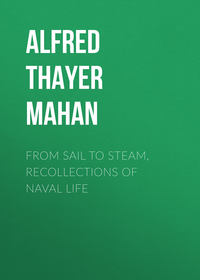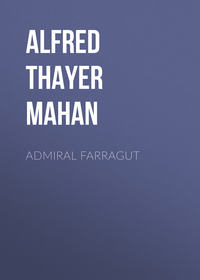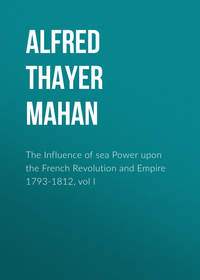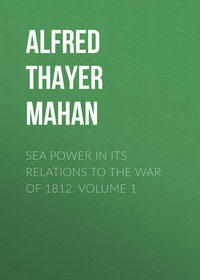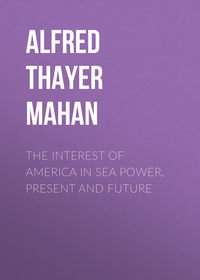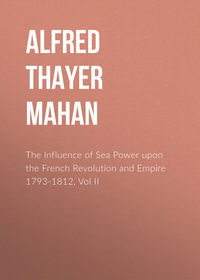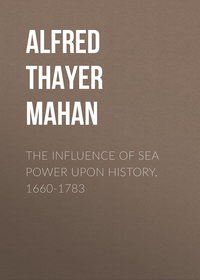 полная версия
полная версияThe Major Operations of the Navies in the War of American Independence
The British total of killed and wounded was very evenly distributed throughout the fleet. Only the rear ship lost an important spar,—the main topmast. It was upon her, as already mentioned, and upon the two leading ships, the Exeter and Isis, that fell the heaviest fire, proportionately, of the French. From the position of the seven van ships of the latter, such fire as they could make must needs be upon the extreme British van, and the Exeter was forced to leave the line. The loss of the French that day was 82 killed and 255 wounded; of which 64 killed and 178 wounded belonged to the Héros, Illustre, and Ajax. The British had 51 killed and 283 wounded; the greatest number of casualties in one ship being 56. Singularly enough, in such a small list of deaths, three were commanding officers: Captains Watt of the Sultan, Wood of the Worcester, and Lumley of the Isis.
At 5.30 P.M. the wind shifted suddenly from south-west to east-south-east (C). The British wore together, formed on the other tack, and continued the fight. It was during this final act, and at 6 P.M., that the mainmast of the French flagship came down. The van ships of the French had towed their heads round with boats before 4, in order to come to the support of the centre, in obedience to a signal from Suffren; but the light airs and calms had retarded them. With the shift they approached, and passed in column (c) between their crippled vessels and the enemy. This manœuvre, and the failure of daylight, brought the battle to an end. According to Hughes's report, several of his fleet "were making much water from shot-holes so very low down in the bottom as not to be come at to be effectually stopped; and the whole had suffered severely in their masts and rigging." Trincomalee being in the enemy's possession, and the east coast of Ceylon an unsafe anchorage now, at the change of the monsoon, he felt compelled to return to Madras, where he anchored on the 9th of September. Suffren regained Trincomalee on the 7th of the month, but the Orient, 74, running ashore at the entrance and being lost, he remained outside until the 17th, saving material from the wreck.
The break-up of the south-west monsoon, then at hand, is apt to be accompanied by violent hurricanes, and is succeeded by the north-east monsoon, during which the east coasts of the peninsula and of Ceylon give a lee shore, with heavy surf. Naval operations, therefore, were suspended for the winter. During that season Trincomalee is the only secure port. Deprived of it, Hughes determined to go to Bombay, and for that purpose left Madras on the 17th of October. Four days later a reinforcement of five ships of the line arrived from England, under Commodore Sir Richard Bickerton, who at once followed the Commander-in-Chief to the west coast. In the course of December the entire British force was united at Bombay.
In Trincomalee Suffren had a good anchorage; but the insufficiency of its resources, with other military considerations, decided him to winter at Acheen, at the west end of Sumatra. He arrived there on the 2d of November, having first paid a visit to Cuddalore, where the Bizarre, 64, was wrecked by carelessness. On the 20th of December he left Acheen for the Coromandel coast, having shortened his stay to the eastward for reasons of policy. On the 8th of January, 1783, he was off Ganjam, on the Orissa coast, and thence reached Trincomalee again on the 23d of February. There he was joined on the 10th of March by three ships of the line from Europe: two 74's and one 64. Under their convoy came General de Bussy, with twenty-five hundred troops, which were at once despatched to Cuddalore.
On the 10th of April Vice-Admiral Hughes, returning from Bombay, passed Trincomalee on the way to Madras, The various maritime occurrences, wrecks and reinforcements, since the battle of September 3d had reversed the naval odds, and Hughes now had eighteen ships of the line, one of which was an eighty, opposed to fifteen under Suffren. Another important event in the affairs of India was the death of Hyder Ali, on the 7th of December, 1782. Although his policy was continued by his son, Tippoo Saib, the blow to the French was serious. Under all the conditions, the British authorities were emboldened to attempt the reduction of Cuddalore. The army destined to this enterprise marched from Madras, passed round Cuddalore, and encamped south of it by the shore. The supply-ships and lighter cruisers anchored near, while the fleet cruised to the southward. Being there to windward, for the south-west monsoon had then set in, it covered the operations against disturbance from the sea.
Towards the beginning of June the investment of the place was complete by land and by water. Intelligence of this state of things was brought on the 10th of June to Suffren, who by Bussey's direction was keeping his inferior fleet in Trincomalee until its services should be absolutely indispensable. Immediately upon receiving the news he left port, and on the 13th sighted the British fleet, then at anchor off Porto Novo, a little south of Cuddalore. Upon his approach Hughes moved off, and anchored again five miles from the besieged place. For the next two days the French were baffled by the winds; but on the 17th the south-west monsoon resumed, and Suffren again drew near. The British Vice-Admiral, not caring to accept action at anchor, got under way, and from that time till the 20th remained outside, trying to obtain the weather-gage, in which he was frustrated by the variableness of the winds. Meanwhile Suffren had anchored near the town, communicated with the general, and, being very short of men at the guns, had embarked twelve hundred troops for his expected battle; for it was evident that the issue of the siege would turn upon the control of the sea. On the 18th he weighed again, and the two fleets manœuvred for the advantage, with light baffling airs, the British furthest from shore.
On the 20th of June, the wind holding at west with unexpected constancy, Hughes decided to accept the attack which Suffren evidently intended. The latter, being distinctly inferior in force,—fifteen to eighteen,—probably contemplated an action that should be decisive only as regarded the fate of Cuddalore; that is, one which, while not resulting in the capture or destruction of ships, should compel his opponent to leave the neighbourhood to repair damages. The British formed line on the port tack, heading to the northward. Suffren ranged his fleet in the same manner, parallel to the enemy, and was careful to see the order exact before bearing down. When the signal to attack was given, the French kept away together, and brought-to again on the weather beam of the British, just within point-blank range. The action lasted from shortly after 4 P.M. to nearly 7, and was general throughout both lines; but, as always experienced, the rears were less engaged than the centres and vans. No ship was taken; no very important spars seem to have been shot away. The loss of the British was 99 killed, 434 wounded; of the French, 102 killed, 386 wounded.
As the ships' heads were north, the course of the action carried them in that direction. Suffren anchored next morning twenty-five miles north of Cuddalore. There he was sighted on the 22d by Hughes, who had remained lying-to the day after the fight. The British Vice-Admiral reported several ships much disabled, a great number of his men—1,121—down with scurvy, and the water of the fleet very short. He therefore thought it necessary to go to Madras, where he anchored on the 25th. Suffren regained Cuddalore on the afternoon of the 23d. His return and Hughes's departure completely changed the military situation. The supply-ships, upon which the British scheme of operations depended, had been forced to take flight when Suffren first approached, and of course could not come back now. "My mind is on the rack without a moment's rest since the departure of the fleet," wrote the commanding general on the 25th, "considering the character of M. de Suffren, and the infinite superiority on the part of the French now that we are left to ourselves."
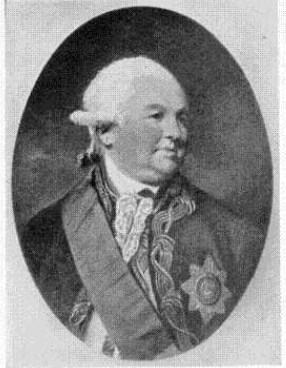
Sir Edward Hughes, K.B.

Pierre André de Suffren de Saint Tropez
The battle of June 20th, 1783, off Cuddalore, was the last of the maritime war of 1778. It was fought, actually, exactly five months after the preliminaries of peace had been signed on January 20th, 1783. Although the relative force of the two fleets remained unchanged, it was a French victory, both tactically and strategically: tactically, because the inferior fleet held its ground, and remained in possession of the field; strategically, because it decided the object immediately at stake, the fate of Cuddalore, and with it, momentarily at least, the issue of the campaign. It was, however, the triumph of one commander-in-chief over another; of the greater man over the lesser. Hughes's reasons for quitting the field involve the admission of his opponent's greater skill. "Short of water,"—with eighteen ships to fifteen, able therefore to spare ships by detachments for watering, that should not have happened; "injury to spars,"—that resulted from the action; "1,121 men short,"—Suffren had embarked just that number—1,200—because Hughes let him communicate with the port without fighting. Notwithstanding the much better seamanship of the British subordinates, and their dogged tenacity, Suffren here, as throughout the campaign, demonstrated again the old experience that generalship is the supreme factor in war. With inferior resources, though not at first with inferior numbers, by a steady offensive, and by the attendant anxiety about Trincomalee impressed upon the British admiral, he reduced him to a fruitless defensive. By the seizure of that place as a base he planted himself firmly upon the scene of action. Able thus to remain, while the British had to retire to Bombay, he sustained the Sultan of Mysore in his embarrassing hostility to the British; and in the end he saved Cuddalore by readiness and dexterity despite the now superior numbers of the British fleet. He was a great sea-captain, Hughes was not; and with poorer instruments, both in men and ships, the former overcame the latter.
On the 29th of June a British frigate, the Medea, bearing a flag of truce, reached Cuddalore. She brought well-authenticated intelligence of the conclusion of peace; and hostilities ceased by common consent.
GLOSSARY
OF NAUTICAL AND NAVAL TERMS USED IN THE TEXT
(This glossary is intended to cover only the technical expressions actually used in the book itself.)
Aback. A sail is aback when the wind blows on the forward part tending to move the vessel astern.
Abaft. Behind, towards the stern.

Aft. See "Bearing."
Ahead. See "Bearing."
Astern. See "Bearing."
Beam. The width of a vessel, so used because of the cross timbers, called beams.
Bear, to. To be in a specified direction from a vessel.
Bear, to. To change the direction of a vessel's movement.
To bear down, to move towards; to bear up, or away, to move away, from the wind or from an enemy.
Bearing. The direction of an object from a vessel; either by compass, or with reference to the vessel itself. Thus, the lighthouse bears north; the enemy bears abeam, or two points off the port bow.
Bearing, Line of. The compass bearing on which the vessels of a fleet are ranged, whatever their bearings from one another.
Bearings, with reference to the vessel.

Abaft the beam, starboard or port, weather or lee. To the rear of abeam, to the right or left, to windward or to leeward.
Before (or forward of) the beam (as above). Ahead of abeam, etc.
Broad. A large angle of bearing, used ordinarily of the bow. "Broad off the bow" approaches "before the beam."
On the bow, starboard or port, weather or lee. To one side of ahead, to right or left, to windward or to leeward.
On the quarter, starboard or port, weather or lee. To one side of astern; to right or left, to windward or to leeward.
Bearings, by compass. The full circle of the compass, 360 degrees, is divided into thirty-two points, each point being subdivided into fourths. From north to east, eight points, are thus named: North; north by east; north-northeast; northeast by north; northeast; northeast by east; east-northeast; east by north; East.
From East to South, from South to West, and from West to North, a like naming is used.
Beat, to. To gain ground to windward, by successive changes of direction, called tacks.
Boom. See "Spars."
Bow, or head. The forward part of a vessel, which is foremost when in motion ahead.
On the Bow. See "Bearing." To head "bows-on": to move directly towards.
Bow and Quarter Line. See pp. 84, 200.
Bowsprit. See "Spars."
Braces. Ropes by which the yards are turned, so that the wind may strike the sails in the manner desired.
Bring-to. To bring a vessel's head as near as possible to the direction from which the wind blows; usually with a view to heaving-to, that is, stopping. See heave-to and luff.
Broadside. The whole number of guns carried on one side of a vessel; starboard or port broadside, weather or lee broadside.
Cable. The heavy rope which was attached to the anchor, and held the ship to it. Cables are now chains, but in the period of this book were always hemp. To veer cable, to let more out, to let the ship go farther from the anchor. To slip the cable, to let it all go overboard, releasing the vessel. Cable's length: 120 fathoms.
Chase, General. A chase by a fleet, in which, in order to more rapid advance, the places of the vessels in their usual order are not to be observed.
Close-hauled. See "Course."
Column. See "Line Ahead."
Come up. A ship comes up, when her bow comes more nearly to the direction of the wind. Used generally when the movement proceeds from some other cause than the movement of the helm. See "Luff."
Convoy. A body of unarmed or weakly armed vessels, in company with ships of war.
Convoy, to. To accompany a number of unarmed vessels, for their protection.
Course. The direction of a vessel's movement, with regard to the compass or to the wind.
Compass course. The point of the compass towards which the vessel heads.
Wind courses:
Close-hauled. As nearly in the direction from which the wind blows as is compatible with keeping the sails full; for square-rigged vessels six points. (See "Bearings by Compass.") For a north wind, the close-hauled courses are east-northeast and west-northwest.
Free. Not close-hauled.
Large. Very free.
Off the wind. Free.
On (or by) the wind. Close-hauled.
Courses. The lowest sails on the fore and main masts.
Cruise, to. To cover a certain, portion of sea by movement back and forth over it.
Cruiser. A general term for armed ships, but applied more specifically to those not "of the line," which therefore are more free and wider in their movements.
Current.
Lee Current. One the movement of which is away from the wind.
Weather Current. One which sets towards the wind.
Ebb, ebb-tide. See "Tide."
Fair, wind. A wind which allows a vessel to head her desired compass course.
Fall Off. A vessel falls off, when, without the action of the helm, her head moves away from the wind. See "Come up."

Flood, flood tide. See "Tide."
Fore and Aft. In classification of vessels, indicates those whose sails, when set, stretch from forward aft; more nearly lengthwise than across. Opposite to square-rigged.
Foremast, fore-topmast, etc. See "Spars."
Foresail, fore-topsail, etc. See "Sails."
Foul, to. To entangle, to collide. A foul anchor, when the cable gets round the anchor.
Foul, wind. A wind which prevents the vessel heading the desired compass course, compelling her to beat.
Free, wind. A wind which allows the vessel to head the course desired. The amount to spare from the close-hauled course is sometimes designated. E.g., the wind four points free; the wind would allow the vessel to come four points nearer the wind than her course requires.
Frigate. See "Vessel."
Gage, weather and lee. A vessel, or fleet, is said to have the weather gage, when it is to windward of its opponent. Lee is opposite to weather.
Haul, to. To haul (to) the wind is to change the course to that nearest the direction whence the wind comes.
To haul down the colors: to strike, to surrender.
Heave Down. To incline a vessel on one side, by purchases at the lower mastheads.
Heave-to. (Hove-to.) To bring-to, (which see), and then to lay some sails aback, in order to keep the ship without movement ahead or astern.
Heel, to. To incline a vessel on one side by shifting the weights on board, such as guns. "On the heel": to be thus inclined.
Helm. The tiller, or bar, which like a handle turns the rudder, and thus changes the course of the vessel.
Port the helm. To put the tiller to port, which turns the vessel's head to the right; to starboard the helm is the reverse.
Helm down. Tiller to leeward, vessel's head to windward; helm up, the reverse. See "Rudder."
Hull. The body of a vessel, as distinguished from the spars, or engines.
Hull, to. (Hulled.) A cannon ball striking the hull of a vessel is said to hull her.
Jib. See "Sails."
Jib-boom. See "Spars."
Keep, to. To keep off, or away, is to change course away from the wind or from an enemy. See "To bear up."
Large. See "Course."
Lee. The direction toward which the wind blows. "Under the lee of," protected from wind and sea by land, or by a vessel, interposed.
Lee Tide. See "Tide."
Leech. The vertical side of a square sail. The upper and lower sides, horizontal, are called head and foot.
Leeward (pronounced looard). Direction of movement, or of bearing, opposite to the wind.
Lie-to, to. To bring the vessels head on, or near, the wind, and remain nearly stopped. Usually in heavy weather, but not always.
Line Abreast. See p. 122.
Line Ahead. See p. 85.
Line of Battle. In the line of battle the vessels are ranged on the same straight line, steering the same course, one behind the others, so that all the broadsides are clear to bear upon an enemy. The line preferred is one of the close-hauled lines, because on them the movement of a vessel in the line is more easily regulated by backing, or shaking, some of the sails.
Line of Bearing. See "Bearing, line of."
Line, Ship of the. A vessel fitted by its force for the line of battle. Opposite generically to "cruiser." The modern term is "battleship."
Luff, to. The movement of changing the course to nearer the direction whence the wind comes, by using the helm.

Mast. See "Spars." "To the mast." A sail is said to be so when aback.
Monsoon. A trade wind, in the China and Indian seas, which blows uniformly from the northeast in winter, and from southwest in summer.
Neap. See "Tide."
Off—the wind. See "Course."
On—the wind. See "Course."
Pennant. A flag, indicating either the rank of the senior officer on board, or a signal applicable to a particular vessel.
Point. See "Bearings, by Compass."
Port. To the left hand, or on the left side, of a vessel, looking from aft forward. Opposite to Starboard.
Port, to. Applied to steering. To move the tiller, or helm, to the left, which moves the rudder to the right and causes the vessel to change course towards the right hand.
Quarter. Either side of the after part of a vessel;—as starboard quarter, port quarter; weather quarter, lee quarter. Quarter deck: one side of the after upper deck, reserved for the officer exercising command, and for ceremonial purposes.
Quarters. A crew is at quarters when at the stations for battle.
Rake, to. To fire the broadside from ahead or astern of an antagonist, so that the shot may sweep the length of the vessel, which at the period of this book was about four times the width.
Random Shot. The extreme range to which a gun could send its shot, giving very uncertain results.
Reef, to. To reduce the surface of a sail.
Rudder. A solid framework, pivoted at the stern of a vessel, which being turned to one side deflects her course. See "Helm" and "Wheel."
Sails. Sails are of two kinds: square, and fore and aft. Square sails spread more across the vessel, in the direction of her width. Fore and aft sails more in the direction of the length. Square sails are better for a free wind; and also for large vessels, because they can be more readily subdivided. Fore and aft sails trim nearer to the wind, and so are convenient for coasters, which generally are smaller.
Vessels carrying square sails are called square-rigged. They have always two masts, usually three; each carrying three or four sails, one above the other. These are named from the mast on which they are carried (see "Spars"); e.g., main sail, fore topsail, mizzen topgallant-sail; and also from their positions on the same mast. Thus, from lowest up, main sail, main topsail, main topgallantsail; and main royal, if there be a fourth. The fore and main sails are called also courses.
The topsails were the chief battle sails, because the largest, except the courses, and more manageable than the courses.
All square-rigged vessels carry fore and aft sails, three cornered, stretched between the bowsprit and jib-booms, and the fore topmast. These sails are called jibs.
Fore and aft vessels also carry jibs; but on each upright mast they have one great sail, the size of which makes it less easily handled in an emergency, therefore less fit for fighting. Above the big sail they have a small, light, three-cornered topsail, but this is merely a fair weather sail, useless in battle.
Vessels of war were almost all square-rigged, with three masts.
Sails, Studding. Light square sails, for moderate weather, extended beyond the other square sails, to increase the normal spread of canvas. Set only with a free wind, and never in battle.
Scantling. The size, and consequent weight and strength, of the timbers of a vessel's hull.
Schooner. See "Vessel."
Shake, to. So to place a sail that the wind blows along it, neither filling nor backing. The sail is thus neutralized without taking in.
Sharp-up. A yard is sharp-up, when turned by the braces as far as the rigging of the mast will allow. A close-hauled course requires the yards to be sharp-up, in order that the sails may be full.
Ship. See "Vessel."
Slip. See "Cable."
Sloop. See "Vessel."
Spars. A spar is a long piece of timber, cylindrical, tapering, in masts, towards one end, and in yards towards both. Spars serve for spreading the several sails of a vessel.
The names of spars vary with their use and position. Chiefly, for ships of war, they divide into masts, yards, and booms.
A mast is an upright, and is in three connected pieces: the lower mast, the topmast, and the top-gallant-mast. Most ships of war had three such masts: fore, near the bow; main, near the centre; mizzen, near the stern.
The bowsprit is also a mast; not upright, but projecting straight ahead from the bow, approaching horizontal, but inclining upwards. Like the masts, it has three divisions: the lower, or bowsprit proper, the jib-boom, and the flying-jib-boom.
Across the masts, horizontal, are the yards, four in number, lower, topsail, topgallant, and royal. Yards are further designated by the name of the mast to which each belongs; e.g., foreyard, main topsail yard, mizzen topgallant yard, main royal yard.




